It seems we are going to get philosophical travel quotes with our daily program. Nice!
“Life is either a daring adventure or nothing .”
~ Helen Keller
Being extraordinarily overtired and having been rocked to sleep by the ship, I slept in uncustomarily late – an impressive 0730. We woke up to some very beautiful and moody foggy conditions over lovely calm sea. The ‘fog bow’ picture below was taken by a fellow passenger, Shona. It was not long afterwards that breakfast was announced over the ship’s public address system and we all dressed and filed downstairs for a fabulous buffet breakfast.
 After breakfast, we had another briefing, this time about the delicate Antarctic environment and the IAATO (International Association of Antarctic Tour Operators) conventions – that would govern our visit to the Antarctic region, followed by a zodiac watercraft safety briefing. We discussed the challenges we would find with our itinerary seeing we were going so far south. Our itinerary was one of the few that Quark offers that actually goes south far enough to cross the Antarctic Circle… this is the last trip the Ocean Diamond will do this year, and this is only the second time our Expedition Team were going to cross the Circle this season. Most people who journey to the Antarctic (tourists like us, I should say, not researchers and scientists) will take a trip that takes in the Falklands, the South Shetland Islands and/or the South Georgia Islands and then hit the tip of the Antarctic Peninsula before heading back across the Drake… our itinerary was basically to hightail it as far south as possible to come around Adelaide Island and into Marguerite Bay (at around 68° south) before slowly winding our way back up the Antarctic Peninsula, stopping where conditions permitted.
After breakfast, we had another briefing, this time about the delicate Antarctic environment and the IAATO (International Association of Antarctic Tour Operators) conventions – that would govern our visit to the Antarctic region, followed by a zodiac watercraft safety briefing. We discussed the challenges we would find with our itinerary seeing we were going so far south. Our itinerary was one of the few that Quark offers that actually goes south far enough to cross the Antarctic Circle… this is the last trip the Ocean Diamond will do this year, and this is only the second time our Expedition Team were going to cross the Circle this season. Most people who journey to the Antarctic (tourists like us, I should say, not researchers and scientists) will take a trip that takes in the Falklands, the South Shetland Islands and/or the South Georgia Islands and then hit the tip of the Antarctic Peninsula before heading back across the Drake… our itinerary was basically to hightail it as far south as possible to come around Adelaide Island and into Marguerite Bay (at around 68° south) before slowly winding our way back up the Antarctic Peninsula, stopping where conditions permitted.
I chose this itinerary because it was the trip that offered the most time actually *in Antarctica* compared to other trips which spent more time at sea going to the Falklands (where we had already visited last year) and the South Georgia Islands which are sub-Antarctic environments (ie: more greenery, more rock, less dramatic glaciers, icebergs and snow). So this trip was going to be all Antarctica, all the way – and even the Expedition Staff seemed excited about going this far south of the Circle this late in the season.
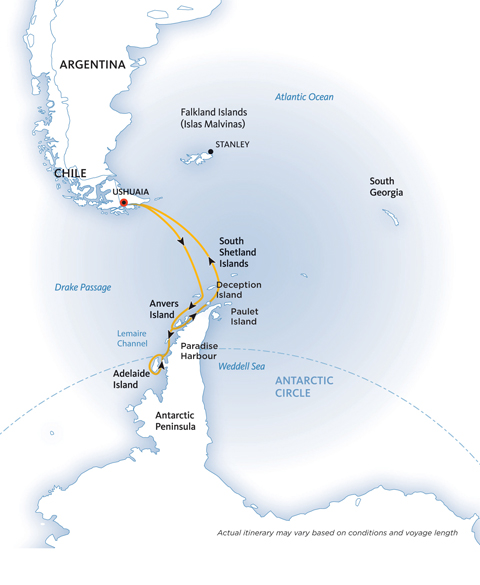
As it happens, Quark is one of the founding members of the IAATO organization whose goal is to have eco-responsible tourism occurring in the Antarctic and Arctic regions. They have a mission to leave the Antarctic pristine, ensuring visitors leave no rubbish, disturb no wildlife and take no plant or rock souvenirs home. There are strict guidelines and procedures in place for how tours can be conducted in Antarctica which includes stringent biosecurity measures – they do not want tourists unwittingly introducing exotic plant, animal or bacterial material to any of the delicate Antarctic ecosystems.
 One of these measures involves getting passengers to have any garments or backpacks or walking poles that will be used on the Peninsula checked by the Expedition Team for seeds, soil or plant matter. Basically, anything that was not purchased brand new for this trip that we were planning on taking with us when we left the ship on excursions (particularly outer layer garments), had to be checked by staff. The staff had set up vacuuming stations on each level of the ship and passengers were called through to have their backpacks and garments inspected and vacuumed for minute particles. Additionally, a washing station was set up on the lower decks to have walking poles, tripods and monopods scrubbed in disinfectant. The Expedition Team impressed upon us how seriously they take this responsibility, and the biosecurity checking took a number of hours as they called passengers from each deck to vacuum and check our things.
One of these measures involves getting passengers to have any garments or backpacks or walking poles that will be used on the Peninsula checked by the Expedition Team for seeds, soil or plant matter. Basically, anything that was not purchased brand new for this trip that we were planning on taking with us when we left the ship on excursions (particularly outer layer garments), had to be checked by staff. The staff had set up vacuuming stations on each level of the ship and passengers were called through to have their backpacks and garments inspected and vacuumed for minute particles. Additionally, a washing station was set up on the lower decks to have walking poles, tripods and monopods scrubbed in disinfectant. The Expedition Team impressed upon us how seriously they take this responsibility, and the biosecurity checking took a number of hours as they called passengers from each deck to vacuum and check our things.
We were also informed of procedures that would occur after zodiac landing expeditions where we would have our boots hosed down and then we would be required to step through trays of disinfectant upon arrival back at the ship to stop any cross-pollination of bacteria, pollens, seeds or plant matter from site to site as we travel along the Peninsula… If it all sounds a bit full on or over the top – just do a Google image search for ‘Mt Everest rubbish dump’… climbers have been abandoning rubbish, excess food, spent oxygen cylinders and extraneous camping equipment at Mt Everest base came for about 80 years, and there is now literally tonnes of rubbish scattered about in one of the most remote environments on earth that environmentalists are working hard to bring back down for suitable disposal. I certainly appreciate the efforts being made to keep Antarctica a pristine environment, and for a change, not a single tourist here appeared to be complaining about these regulations being an inconvenience. I guess the type of person who is attracted to an Antarctic voyage with a company like Quark, already has a keen appreciation for the delicate nature of the remote environments we will be entering into and likewise, wants to see them preserved and protected.
The biosecurity measures took quite some time and while it was going on we were being called deck by deck to collect a pair of Muck boots. In another effort to ensure the safety and comfort of passengers, Quark lends their pax a pair of high quality insulated rubber boots for use during the expedition. These boots are designed to keep your feet warm and dry during zodiac excursions and it meant none of us had to go to the expense of buying expensive single-use footwear for the trip. The boots themselves are very heavy duty and finding the right size turned out to be kinda difficult – I have tiny feet and these are men’s boots; in men’s boots I would ordinarily be wearing a size 4, but there was no way I was going to fit my calf into boots that are designed for a ten-year-old boy. So with some really thick socks, I opted for the size 5, but like many short chicks who aren’t the skinniest of minnies, they were still stupidly restrictive around the calf – like seriously, cutting off my circulation, restrictive. So I tried on a 6 but then my foot was slipping around inside the boot too much. :/
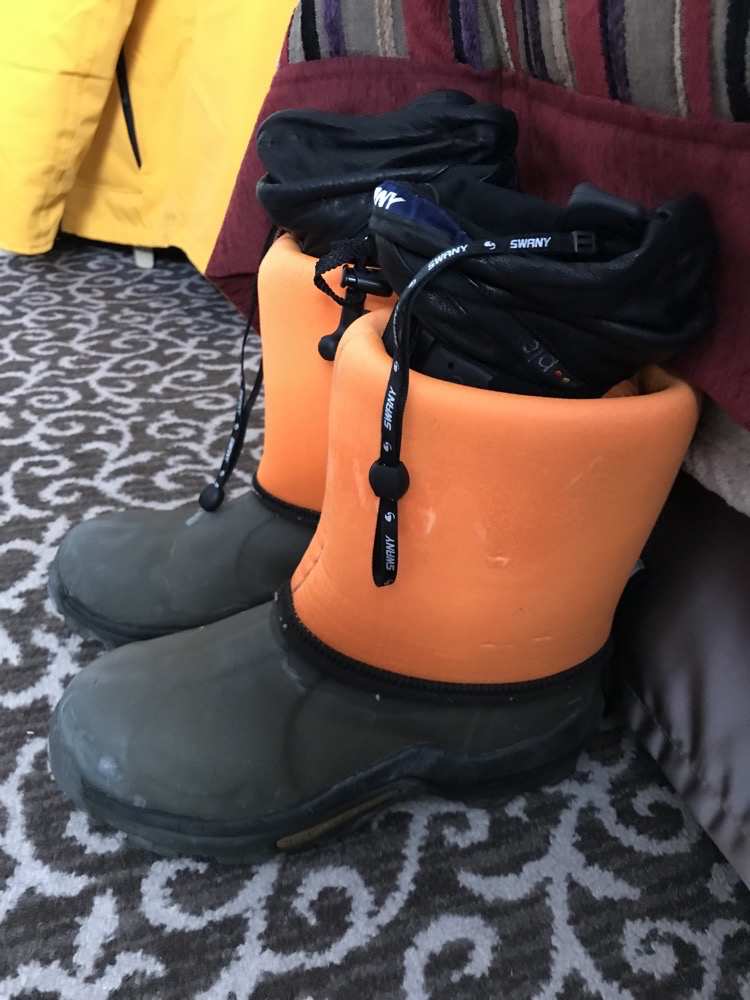
Oh well, I was just going to have to take the size 5s, fold the boots over and hope we didn’t get into any water deeper than a few inches… I wasn’t alone on this one, plenty of women found the boots too tight around their calves tiny feet or not. It will likely be doubly so once we put on our layers of warmth under our waterproof outer-pants. And if we thought trying them on was hard, taking them off was doubly difficult! Once your foot was securely into the boots, trying to lever them off was really hard. The easiest way to accomplish this unexpectedly difficult task is to have your roommate pull them off for you and then you can pull theirs off for them! 🙂
All of this preparation for our excursions took several hours and before we know it, it was suddenly lunchtime. Lunch was again served in the Dining Room and was quite an impressive buffet of salads and warm dishes, soups and stirfry, sandwiches and hamburgers were also on offer – they were obviously planning on totally over feeding us this trip. The sea had been getting rougher as the day wore on and there were noticeably fewer people attending lunch today than dinner last night. Mind you – it didn’t look rough outside, just long rolling swells that didn’t seem all that agreeable to some people.
 Our fearless Expedition Leader, David Wood (‘Woody’, yes of course he’s Australian) would come to call this sort of weather, ‘romantic’ or ‘dramatic’… with him there was no such things as ‘good’ or ‘bad’ weather.
Our fearless Expedition Leader, David Wood (‘Woody’, yes of course he’s Australian) would come to call this sort of weather, ‘romantic’ or ‘dramatic’… with him there was no such things as ‘good’ or ‘bad’ weather.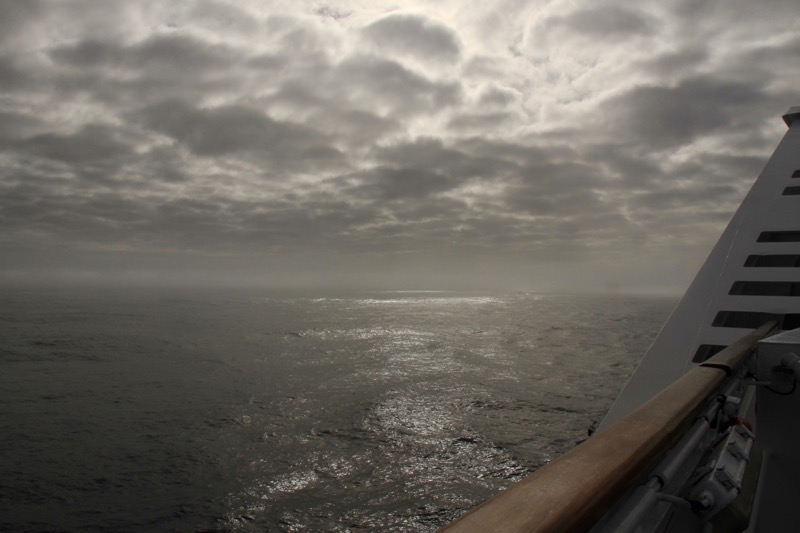
After lunch, we had two lectures, the first on ‘Birds of the Southern Ocean’s with the onboard ornithologist Liliana. Did I mention how incredibly qualified and overachieving the entire Expedition Team are? There are more PhDs and professional qualifications among this lot than you see at your average academic conference – I certainly wasn’t expecting that.
It was very interesting, I learned that seabirds or sentinels are designated such due to spending most of their lives at sea and only returning to land to breed. Unfortunately populations of various seabirds have decreased by approximately 50% over the last 70 years, largely due to pollution and habitat and food source depletion. Seabirds generally have quite a long lifespan and can live up to 70 years – there is one Lazen Albatross, named Wisdom who was tagged as a chick and who has her own Facebook page so she is known to be 67 years old, and is apparently breeding again. Incredible.
I also learned that most seabirds are ‘philopatric’ – which means they are attached to their place of origin to breed, whether it is to a certain colony or a certain island, or even as specific as a certain slope on a certain island within a certain colony. The come back to the exact same spot when they are mature enough to breed themselves. Philopatric animals are very sensitive to changes in their environments – for example, there is a colony of Atlantic Puffins that is suffering considerably from fishing depletion in their attachment area and they are unable to find fish small enough to be ingested by their chicks. The adult birds are currently okay, they can consume the larger fish, but they continue to breed in the same place and they repeatedly feed their chicks with fish that are too large for the chicks to eat. As a result, the chicks are starving. The adult birds however, continue to return to the same rookery each year and try again to breed a chick. It’s really very sad.
Recently, as in the last week or so, an entirely new colony of Adelie penguins has been found on remote southern side of the Antarctic Peninsular where drone explorations found 1.5 million nesting pairs that were not known to inhabit the area. That is 3 million Adelie penguins and as many as 1.5million chicks that were previously unknown to researchers, and Liliana as an Antarctic ornithologist was very excited about this find because Adelies have a small clutch size and very slow chick growth rate, so it is very promising for the Adelies. Most seabirds tend to breed in large colonies like this, as this gives the large group a better chance to survive predators, and it is easier for them to show each other where sources of food have been found. The downside is that disease can spread through a colony very rapidly due to the close proximity.
It was at this lecture that I learned all about the Antarctic Convergence or the Polar Front, which basically affects all life in the Antarctic. The Antarctic Convergence is where water masses up to 1000-2000m deep that circulate in the Southern Oceans meet warmer waters from ocean currents in the north and are lifted towards the surface as they approach Antarctica, bringing water to the surface that is rich in nutrients and krill. The Antarctic Convergence encircles the Antarctic continent and moves in latitude each year depending on currents and variations in water temperatures etc. However, between South America and Antarctica, there is not much room for the Front to move so it remains fairly consistent and predictable, so it makes for a good place to look for seabirds, whales and other sea mammals that survive on phytoplankton, zooplankton and krill etc. I knew nothing about this phenomena – I feel like I’ve been living in ignorance.
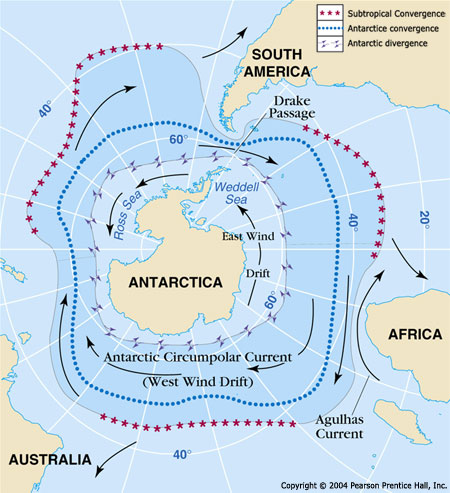 There are many seabirds prevalent in these convergence regions from Great Albatross, Grey Albatross, Great Southern Royal Albatross (enormous birds with a wingspan of 3m) down to smaller petrels, cormorants and terns. Too many to list here. The most interesting thing I learned about any of these seabirds during this lecture is they tend to spend most of their life in flight – and that they actually expend more energy when being on the surface of the water than when gliding in the air over the water’s surface. It turns out that these birds (and some seals too) are capable of unihemispheric single wave sleep while sleeping – that is, they can shut down half their brain and let it go to sleep while the other half of their brain keeps the body functioning and in this case, flying, allowing them to remain flying for many more hours of the day.
There are many seabirds prevalent in these convergence regions from Great Albatross, Grey Albatross, Great Southern Royal Albatross (enormous birds with a wingspan of 3m) down to smaller petrels, cormorants and terns. Too many to list here. The most interesting thing I learned about any of these seabirds during this lecture is they tend to spend most of their life in flight – and that they actually expend more energy when being on the surface of the water than when gliding in the air over the water’s surface. It turns out that these birds (and some seals too) are capable of unihemispheric single wave sleep while sleeping – that is, they can shut down half their brain and let it go to sleep while the other half of their brain keeps the body functioning and in this case, flying, allowing them to remain flying for many more hours of the day.
Sorry if this is boring but I thought it was fascinating stuff… they were preparing us to better understand what we would likely be seeing over the coming weeks, but after this lecture, I was mostly just wishing humans were capable of unihemispheric sleep! 😀
After our bird lecture, there was an “Antarctica In the Imagination: Pre-History” with Justine our onboard historian, which I am told was very interesting, but unfortunately, I missed it and hope to catch up on this one later.
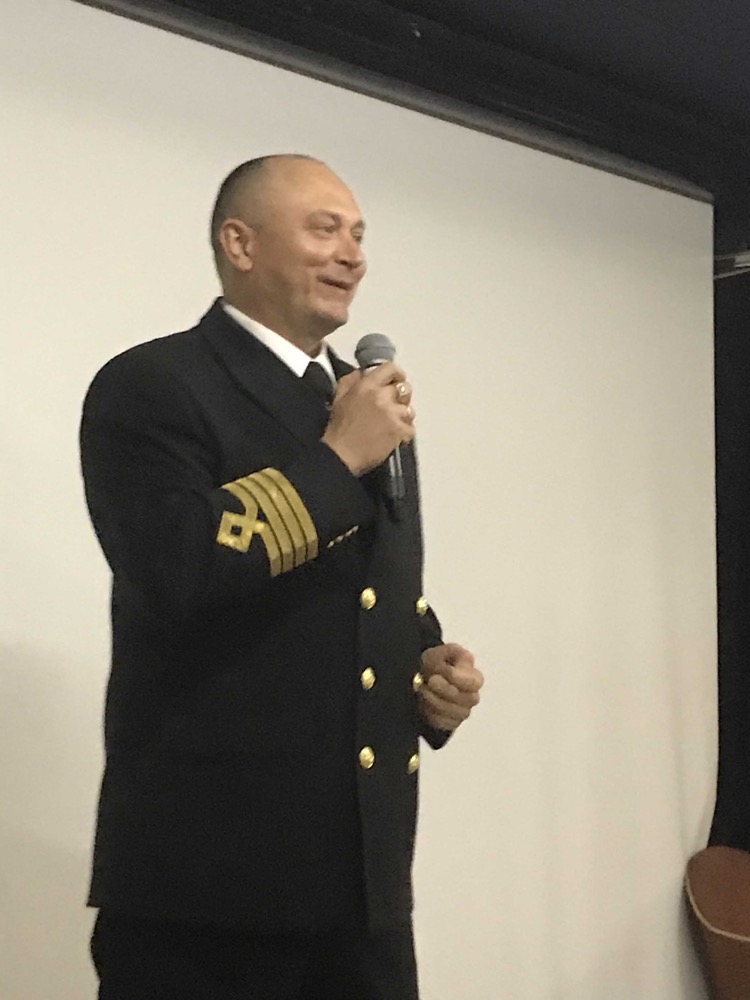 At 1800 we had our Daily Recap and Briefing in the Main Lounge which apparently will happen every day to go over the things we saw each day and to give a brief overview of what to expect the next day.
At 1800 we had our Daily Recap and Briefing in the Main Lounge which apparently will happen every day to go over the things we saw each day and to give a brief overview of what to expect the next day.
Then it was 1900 and a Welcome Cocktail party to meet Captain Oleg Klaptenko from Russia, and his staff – free champagne and canapés. The Captain (yet another one who says his public speaking is terrible) issued an open invitation for passengers to visit the bridge whenever we wanted to. We were then treated to a wonderful Welcome Dinner in the main Dining Room.
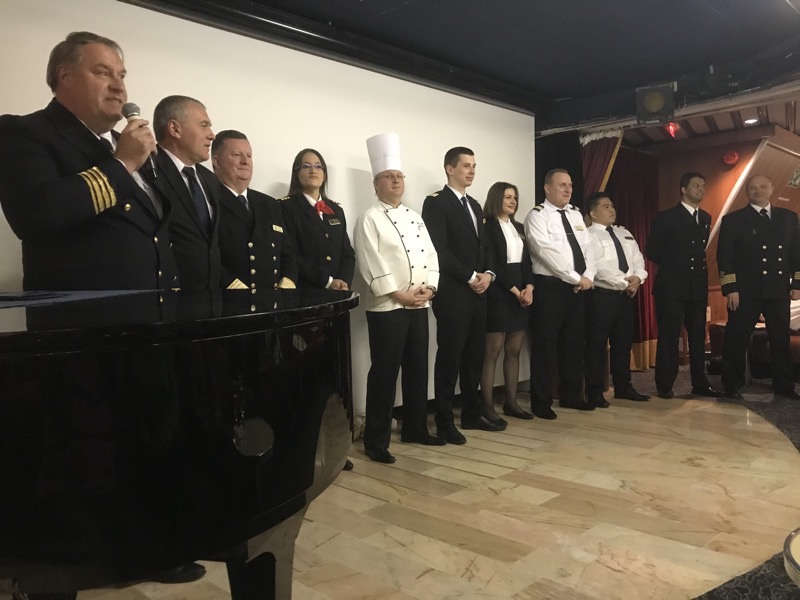
We had another delicious meal – this time of mushroom soup, beautifully cooked Argentinian tenderloin beef and vegetables, followed by cheese and crackers (obviously there were other choices, but this is what I chose for dinner), and of course, more complimentary wine with dinner. I don’t know why, but I was expecting more rudimentary meals than we were used to on cruise ships, this being an expedition type voyage – but we were on a fabulous floating restaurant, with an Austrian chef named Gunter who had a wonderful habit (that I heartily endorse) of supplying an enormous wheel of blue cheese at every meal!
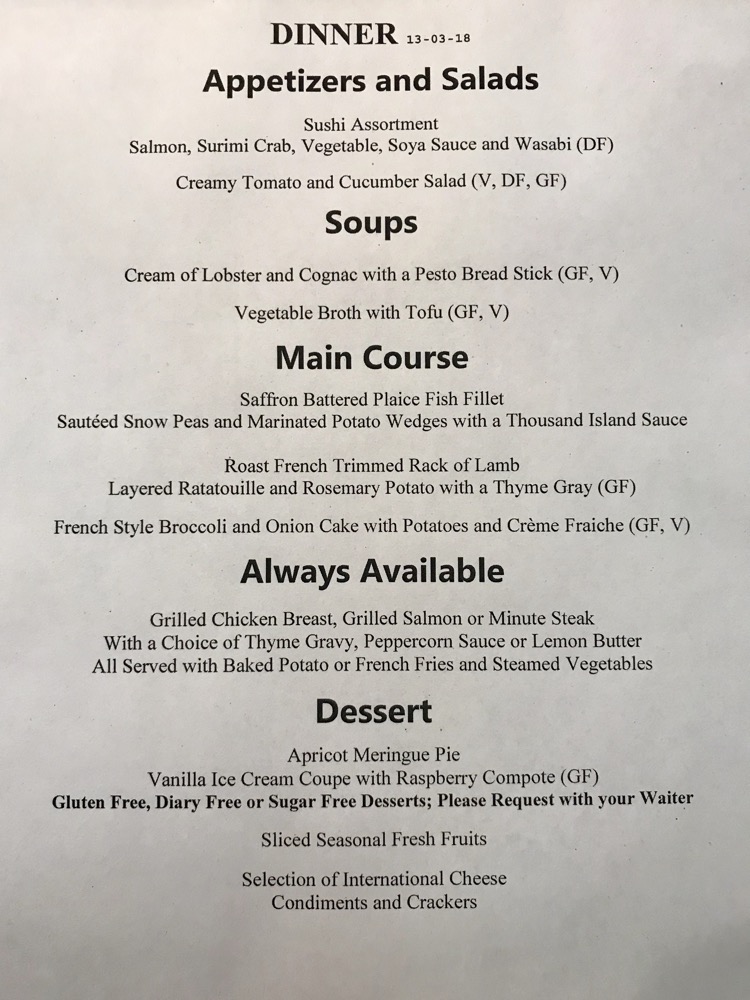
I did eventually remember to take some photos in the dining room… 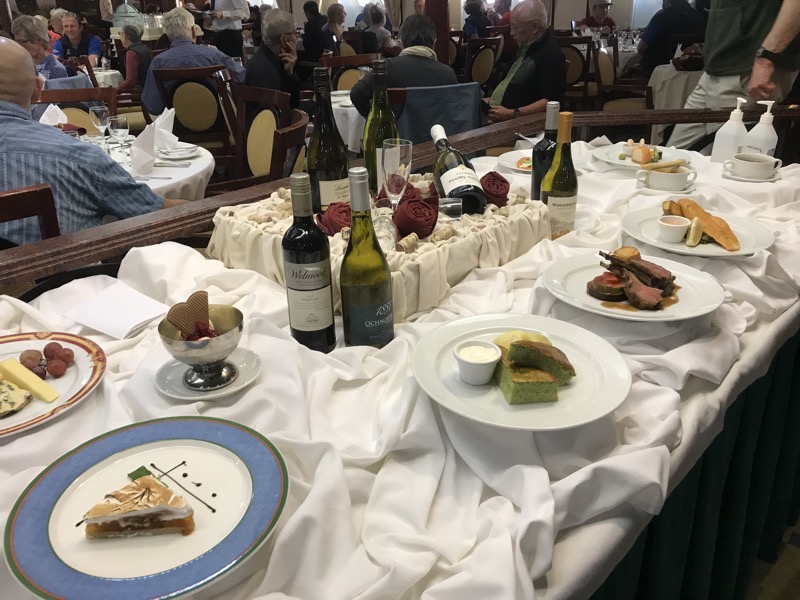
After dinner many of us met in The Club bar to have a casual talk with Woody on ‘Maritime Superstitions’.
Woody started off his informal chat about superstitions by explaining that superstitions are about belief – so if you believe it, it will be true (for you at least) and people will continually frame a narrative that reinforces their belief system. If this sounds like religion to you – well, yes. It may as well be.
Anyway, he had a list as long as your arm of ‘Bad Luck’ superstitions:
- No whistling on ships – Captains on many ships will insist on no whistling on their ships and have been known to put people ashore for continuing to whistle, it apparently brings bad weather and the association is likely with the whistling noise high winds make in the sails.
- Woody asked us how many of us looked back to Ushuaia as we left port, to which about 80% of the room put up their hands, whereupon he informed us it was bad luck to be looking back – you must always be looking forward on a ship. It is extremely bad luck to be looking behind you from the bridge for very obvious reasons… on the bridge you need to be alert to hazards in front of you!
- Black travel bags and luggage are also assocated with bad luck, merely because of black being the colour of death and darkness.
- Another more modern ‘bad luck’ superstition is to never say the ‘T” word on a ship – and if you don’t know what I mean by the “T” word, it was the name of a movie made in 1997 staring Kate Winslet and Leonardo di Caprio staring an enormous wrecked ship.
- More unlucky words “Rabbit” and “Rat” – instead you can say “Bunny” or “Rodent with the Long Tail”. Woody had no concrete ideas on where this one is coming from but apparently, French sailors in particular, are very superstitious about rabbits and rats?!
- Killing am albatross is bad luck – though many expeditions into the Southern Oceans found albatross a godsend when they had run out of supplies.
- When drinking, you do not chink glasses as the ringing sound made from the glasses colliding means a sailor loses his soul. Instead sailors will salute one another by putting glasses together but ensuring that hands connect with hands instead of allowing glass to connect with glass. If glass accidentally connects with glass, sailors will often cover the glass to smother the ringing sound as soon as possible.
- When cooking whole fish on a ship and the meat has been removed from the topside of the fish, the fish should not be turned over to gain access to the meat on the bottom of the fish. This action is believed to cause ships to capsize. Instead the meat on top should be eaten, the bones removed and the bottom meat then accessed.
- It is apparently very bad luck to rename a ship. Shackleton bought a ship called ‘The Polaris’ and promptly renamed it ‘The Endurance’ which then turned around and sank (in sailing lore, this of course had nothing to do with the ice, but rather because the ship was renamed!). Another example of bad luck following a ship with a name change with the USS Phoenix which survived the bombing of Pearl Harbour only to later be sold to the Argentinian Navy where it was renamed. It promptly sank in 1982 (again, nothing to do with the Falklands War according to sailors, it was due to the name change!).
- Oddly, the only good way to rename a ship was to do so on the day of a full moon…? Apparently, the Ocean Diamond that we were currently in the middle of the Drake Passage on, has been renamed, but Woody promised us it was done correctly on a full moon… wtf?!
- Priests on board are bad luck – they are dressed in black all the time, and of course priests are heavily associated with death and more darkness and whatnot.
- Bananas! Who would have thought bananas onboard would be bad luck. But apparently Bananas are bad luck as they stop you catching fish. Cargoes of bananas were always run fast to get their produce to market before they went off, so Captains were often pressured by owners to sail faster and take dangerous shortcuts. In addition to that the bananas could quickly ripen and start fermenting in the hold making other stock (like slaves) sick, and they were also prone to carrying insects which then bit the crew. So that one at least kinda makes sense.
‘Good Luck’ superstitions seem somewhat thin on the ground in comparison:
- Albatross and seabirds are considered good luck, as this meant land was hopefully nearby.
- Dolphins were considered good luck, though why, Woody didn’t say
- And THAT’S IT for good luck at sea.
On the balance of things… it seems going to sea is all bad and should be avoided at all costs!
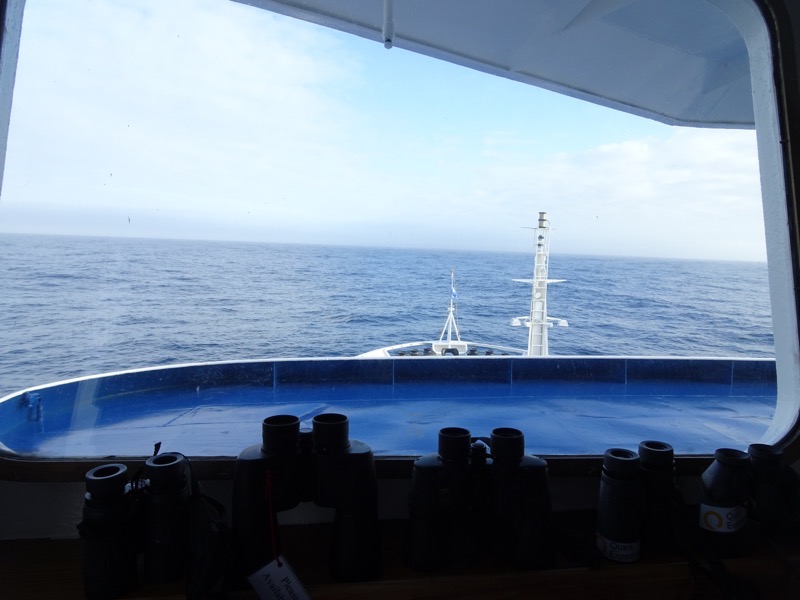 The Bridge has many pairs of binoculars so guests can bird watch, or look for wildlife or even ice bergs. There are also books in here for bird identification and maps of the Antarctic Peninsula.
The Bridge has many pairs of binoculars so guests can bird watch, or look for wildlife or even ice bergs. There are also books in here for bird identification and maps of the Antarctic Peninsula.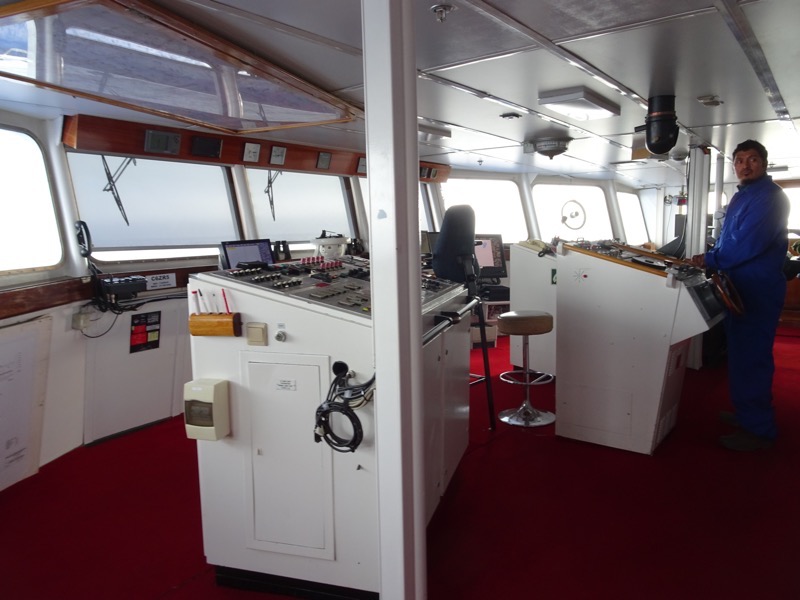
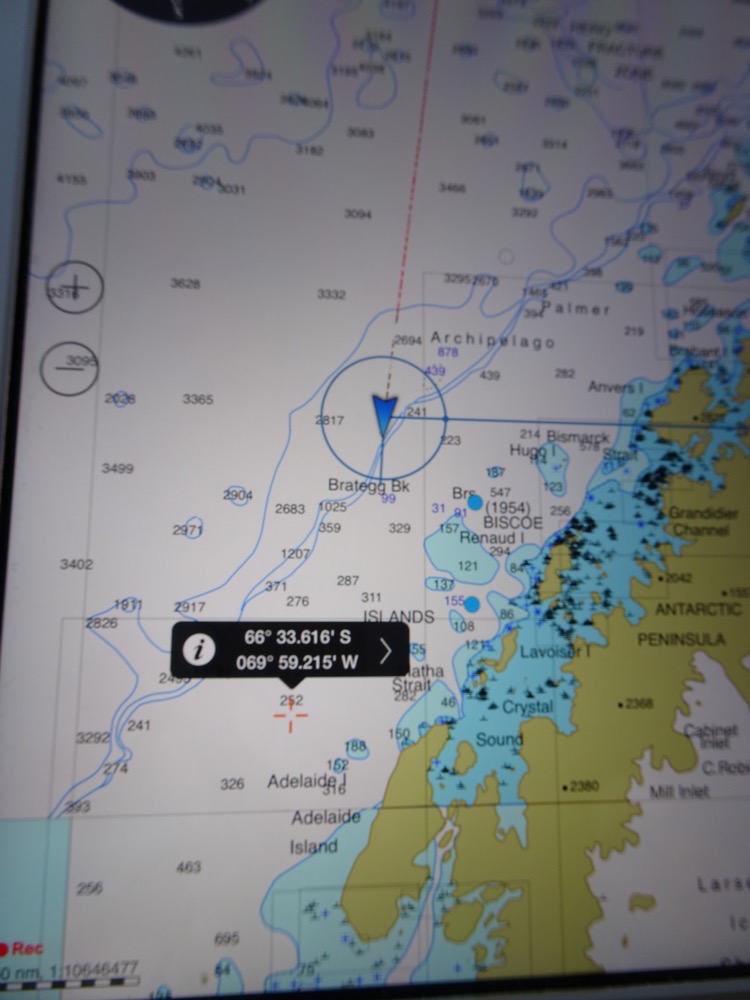
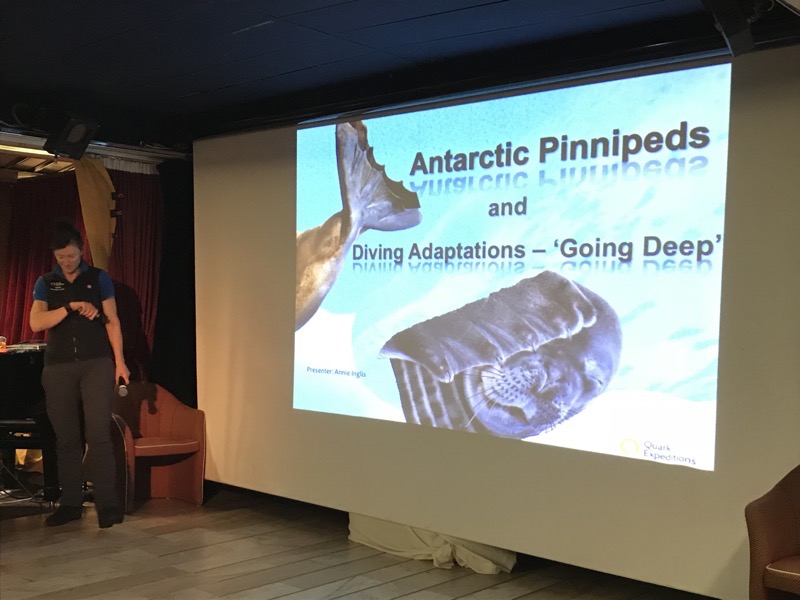 It turns out for those marine biology challenged amongst us that a pinniped is a seal – or a finned, feather-footed marine mammal. Marine mammals are those that derive most of their nutrition from marine environments. For the sake of simplicity, they are effectively the eared and earless seals or Phocidae and Otariidae.
It turns out for those marine biology challenged amongst us that a pinniped is a seal – or a finned, feather-footed marine mammal. Marine mammals are those that derive most of their nutrition from marine environments. For the sake of simplicity, they are effectively the eared and earless seals or Phocidae and Otariidae.
 After breakfast, we had another briefing, this time about the delicate Antarctic environment and the
After breakfast, we had another briefing, this time about the delicate Antarctic environment and the 
 One of these measures involves getting passengers to have any garments or backpacks or walking poles that will be used on the Peninsula checked by the Expedition Team for seeds, soil or plant matter. Basically, anything that was not purchased brand new for this trip that we were planning on taking with us when we left the ship on excursions (particularly outer layer garments), had to be checked by staff. The staff had set up vacuuming stations on each level of the ship and passengers were called through to have their backpacks and garments inspected and vacuumed for minute particles. Additionally, a washing station was set up on the lower decks to have walking poles, tripods and monopods scrubbed in disinfectant. The Expedition Team impressed upon us how seriously they take this responsibility, and the biosecurity checking took a number of hours as they called passengers from each deck to vacuum and check our things.
One of these measures involves getting passengers to have any garments or backpacks or walking poles that will be used on the Peninsula checked by the Expedition Team for seeds, soil or plant matter. Basically, anything that was not purchased brand new for this trip that we were planning on taking with us when we left the ship on excursions (particularly outer layer garments), had to be checked by staff. The staff had set up vacuuming stations on each level of the ship and passengers were called through to have their backpacks and garments inspected and vacuumed for minute particles. Additionally, a washing station was set up on the lower decks to have walking poles, tripods and monopods scrubbed in disinfectant. The Expedition Team impressed upon us how seriously they take this responsibility, and the biosecurity checking took a number of hours as they called passengers from each deck to vacuum and check our things.
 Our fearless Expedition Leader, David Wood (‘Woody’, yes of course he’s Australian) would come to call this sort of weather, ‘romantic’ or ‘dramatic’… with him there was no such things as ‘good’ or ‘bad’ weather.
Our fearless Expedition Leader, David Wood (‘Woody’, yes of course he’s Australian) would come to call this sort of weather, ‘romantic’ or ‘dramatic’… with him there was no such things as ‘good’ or ‘bad’ weather.
 There are many seabirds prevalent in these convergence regions from Great Albatross, Grey Albatross, Great Southern Royal Albatross (enormous birds with a wingspan of 3m) down to smaller petrels, cormorants and terns. Too many to list here. The most interesting thing I learned about any of these seabirds during this lecture is they tend to spend most of their life in flight – and that they actually expend more energy when being on the surface of the water than when gliding in the air over the water’s surface. It turns out that these birds (and some seals too) are capable of
There are many seabirds prevalent in these convergence regions from Great Albatross, Grey Albatross, Great Southern Royal Albatross (enormous birds with a wingspan of 3m) down to smaller petrels, cormorants and terns. Too many to list here. The most interesting thing I learned about any of these seabirds during this lecture is they tend to spend most of their life in flight – and that they actually expend more energy when being on the surface of the water than when gliding in the air over the water’s surface. It turns out that these birds (and some seals too) are capable of  At 1800 we had our Daily Recap and Briefing in the Main Lounge which apparently will happen every day to go over the things we saw each day and to give a brief overview of what to expect the next day.
At 1800 we had our Daily Recap and Briefing in the Main Lounge which apparently will happen every day to go over the things we saw each day and to give a brief overview of what to expect the next day.

